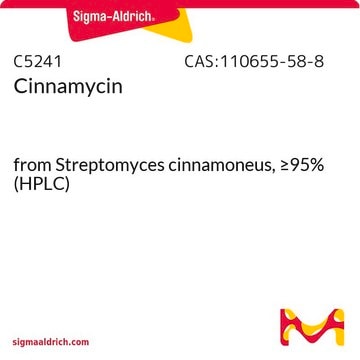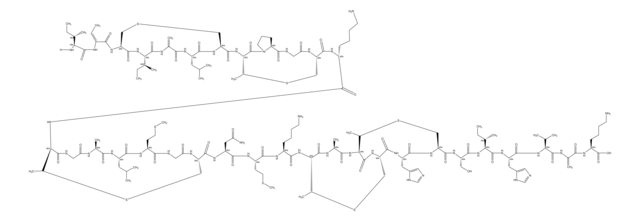L8543
DL-Lanthionine
≥98% (TLC)
Synonym(s):
DL-3,3′-Thiodialanine, S-(2-Amino-2-carboxyethyl)-DL-cysteine
About This Item
Recommended Products
product name
DL-Lanthionine, ≥98% (TLC)
assay
≥98% (TLC)
form
powder
color
white
solubility
1 M HCl: soluble
application(s)
detection
InChI
1S/C6H12N2O4S/c7-3(5(9)10)1-13-2-4(8)6(11)12/h3-4H,1-2,7-8H2,(H,9,10)(H,11,12)
InChI key
DWPCPZJAHOETAG-UHFFFAOYSA-N
Looking for similar products? Visit Product Comparison Guide
Application
- Synthesis of the lantibiotic lactocin S using peptide cyclizations on solid phase.: This research highlights innovative methods for synthesizing peptide-based antibiotics like lactocin S, utilizing dl-lanthionine to form crucial thioether crosslinks that enhance the activity and stability of these peptides (Ross et al., 2010).
- Cystathionine gamma-lyase of Streptomyces phaeochromogenes.: This research documents the isolation and characterization of an enzyme that processes cystathionine, which involves dl-lanthionine as a structural analog, revealing its role in bacterial physiology and potential applications in biotechnology (Nagasawa et al., 1984).
- The availability of dl-lanthionine for the promotion of growth in young rats when added to a cystine- and methionine-deficient diet.: This historical study explores the nutritional value of dl-lanthionine, investigating its ability to substitute for essential amino acids in growth diets, which helps in understanding its potential use in nutritional supplements (Jones et al., 1948).
Biochem/physiol Actions
signalword
Warning
hcodes
Hazard Classifications
Eye Irrit. 2 - Skin Irrit. 2 - STOT SE 3
target_organs
Respiratory system
Storage Class
11 - Combustible Solids
wgk_germany
WGK 3
flash_point_f
Not applicable
flash_point_c
Not applicable
ppe
dust mask type N95 (US), Eyeshields, Gloves
Certificates of Analysis (COA)
Search for Certificates of Analysis (COA) by entering the products Lot/Batch Number. Lot and Batch Numbers can be found on a product’s label following the words ‘Lot’ or ‘Batch’.
Already Own This Product?
Find documentation for the products that you have recently purchased in the Document Library.
Customers Also Viewed
Our team of scientists has experience in all areas of research including Life Science, Material Science, Chemical Synthesis, Chromatography, Analytical and many others.
Contact Technical Service












